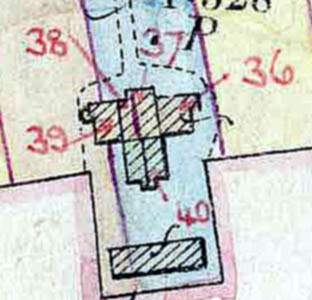
56 to 60 High Street March 2008
56 to 60 High Street is an imposing red brick block of five dwellings with two storeys and attic bedrooms set into a clay tile gambrel roof. The block was listed by the former Department of Environment as Grade II, of special interest, and bears a plaque: W H W 1864 suggesting it was built by William Henry Whitbread in that year. However, this structure was merely remodelled in that year as, prior to 1834, it had been the Parish Workhouse, built in 1802.
Under the original Poor Law of 1601, parishes collected a Poor Rate from those inhabitants not amongst the poor. This rate was collected and administered by a parish official - the Overseer of the Poor (larger parishes had more than one Overseer). He made disbursements of money or food and/or clothes to people who needed it. This was known as giving relief and this relief could be of two types. Outdoor relief was given to people who had their own lodgings and could maintain themselves in them with assistance. Indoor relief was granted to people who either had no dwelling, or were incapable of looking after themselves, this meant that they entered the parish poorhouse or workhouse.
When the word workhouse is used people normally think of the large, grim 19th century institutions housing hundreds of people in ways not dissimilar to a prison. Such institutions were created by the Poor Amendment Act of 1834. Before this individual parishes had their own workhouses, these could, no doubt, be grim but were usually not large.
Bedfordshire & Luton Archives & Records Service holds a number of records concerning the Southill Workhouse. The earliest of these is an agreement of 1722 [P69/18/1] in which the "principal inhabitants and farmers" of Southill "finding the poor rate rises to an Extraordinary some of Monie, and through the Idleness of Manie of our Parish they Increase upon us" agreed to hire a house and fit it up with clothes and other utensils to establish it as a workhouse. An interesting side-light on the plight of the poor comes in a complaint by William Brasier to the Overseer of the Poor in Southill in 1790 [P69/16]. He had "no trade or business, no money at interest, no property save a few household goods, that are barely sufficient, and a wife and family to support". His wife was the widow of another man and had a child from the first marriage to support. She had received a shilling a week for its upkeep for the first six months of its life but the Overseers then stopped the payment and wanted to put the baby into the parish workhouse. Through the help of a friend the mother was able to stop this. After Brasier married the mother the Overseers again agreed to provide a shilling a week maintenance and were still willing to do so. However, they had made a contract with a man to keep the workhouse and he now wanted the child to be taken in - presumably because it would swell the amount he could claim from the parish for expenses in running the place.
It is clear that the workhouse of 1722 was not 56 to 60 High Street as a conveyance of December 1802 [W3832] from Samuel Whitbread II gives the site of a newly built workhouse to the churchwarden and overseers of Southill. The deed reveals that the decision to raise £1,600 build a new workhouse had only been taken by the parish vestry meeting on 8th June 1802 and at the time of the deed, 8th December that year, the workhouse "is now nearly completed". Few old properties can be dated so accurately. The workhouse was built on 5 acres, 2 roods, 29 perches of land called Beeches Piece - the building and land were conveyed to the parish in trust "to be used as a workhouse, with yard and gardens" and the remainder of the land was to be used to keep cows for supplying the inhabitants of the workhouse with milk.
Following the introduction of the Poor Law Amendment Act it quickly became apparent that there was no point in retaining a parish workhouse. The place was, therefore, leased [PUBWE5] in 1837 to Charles Bailey of Bedford for £45 per annum. The premises were then described as: "a brick built messuage or tenement in Southill lately used as the workhouse there with the yard, garden and close of land adjoining containing 4 acres". When the lease expired in 1861 the old workhouse was sold back to the Whitbread Estate for £900 [P69/8/2].
In 1927 Southill was valued under the Rating Valuation Act 1925; every piece of land and building in the country was assessed to determine the rates to be paid on it. The valuer visiting the former workhouse [DV1/C124/36-40] noted that the dwellings were owned by the Whitbread Estate and tenanted by J.Litchfield, L.Hall, G.Massey, S.Davis and D.G.Faulkner respectively at respective rents of £7/1/6, £6/1/6, £5/15/4, £7/2/2 and £6 per annum.
The valuer noted that 56 comprised a living room, kitchen, two bedrooms and a further bedroom in the attic. It also had a barn. He commented: "Said to have been a Workhouse! Very small front and very lofty, converted from one building into 5 cottages". The other properties were broadly similar except that Number 59 had an extra pantry and Number 60 had no attic but a bedroom over the respective kitchens of 57 and 58.

56 to 60 High Street in 1927
The valuers map above shows where each dwelling was (the numbers referring to pages in the valuation book rather than house numbers).